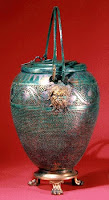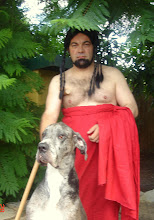It has made a large contribution to the vocabularies of modern languages and was a standard subject of study in Western educational institutions from the Renaissance to the early 20th century. Even some volumes of Asterix have been written in Attic Greek and Harry Potter and the Philosopher's Stone has been translated into Ancient Greek as well. The 2010 science fiction television series Caprica, set in the universe of Battlestar Galactica but years before the events seen in Battlestar Galactica, uses Ancient Greek as a basis for the Tauron language.
In a previous blog I introduced you to the Elpinor site as a Port of Call. They are not the only people teaching the Ancient Greek language. You can kick off by reading these pages:
The Intelligent Person’s Guide To Greek by William Harris Prof. Em. Middlebury College
So You Want to Learn Ancient Greek on Your Own? by Stephen M. Trzaskoma
You should enjoy these sites as well:
Greek Grammar on the Web is perhaps one of the best single source for information about online resources for students of ancient Greek by Prof. Marc Huys. Dr. Huys has divided the sites into easy to use categories . Having visited each of the sites and evaluated their content, he has given them individual ratings as well as provided short summaries. This site was designed to make our lives easy.
Ancient Greek Tutorials, by Donald J. Mastronarde with the assistance of the Berkeley Language Center of the University of California, Berkeley. There is a Unicode and GreekKeys version. This site is made available to all users by the courtesy of the University of California Press. Although much of it is based on a specific textbook for ancient Greek , the tutorials should be helpful to anyone learning ancient Greek from any textbook.
Greek Language and Linguistics - Their primary objective is to foster the application of research methods from the field of Linguistics to the study of Hellenic and Hellenistic Greek. In addition to tools to support learning Ancient Greek, we provide resources to encourage the study of various forms of Linguistics and their application to Ancient Greek. You can select options for Online and Print Resources for beginning Greek, Intermediate Greek and Advanced Studies. Links to blogs and other great resources can be found here as well.
Ancient Greek Online - The author Richard Welland Crowell says the site was designed to be a learning environment for students as well as a reading room for scholars. The large print Greek is easy on the eyes. The Internet has returned us to the scrolling method of reading texts, which lends itself particularly well to the project at hand. I like his polemical tone:”This is a time of crisis for the Humanities. In colleges and universities across the country, Classics departments are being dismantled or simply left to die of attrition as professors retire without being replaced. We are once again entering upon a Dark Age when classical learning is regarded as irrelevant to the poorly understood needs of an increasingly violent and irrational world. Like the Irish monks of the 8th and 9th centuries, we must go quietly about the task of preserving and disseminating the keystones of classical civilization before they are lost from consciousness.”
Textkit -This is an all free language education website. Our core content is our library of freely downloadable Greek language books and our Greek Forums.Textkit was created to help people learn Greek and Latin. They are a free online learning resource that provides downloadable Greek and Latin grammars and readers. They also provide an extensive and ever growing collection of classical e-books in English, Greek and Latin. Wonderful stuff...
World Wide Ancient Greek - Learning Ancient Greek is the interactive, online complement to Cecelia Luschnig's An Introduction to Ancient Greek: A Literary Approach. This is a traditional beginner's text, written in a conversational tone, as though between equals of good will and common purpose. You can find Callias’ Alphabet song on this site. Oops sorry, forgot we are all learners here, Callias was an Athenian comic poet of the 5th c. This song by the chorus may have come from his comedy called the Alphabet Tragedy.
The Linguistic Research Centre at the University of Texas has on offer the seies Classical Greek Online by Winfred P. Lehmann and Jonathan Slocum. This set of lessons is for systems/browsers with Unicode® support, including full Greek script (with polytonic letters). Lessons rendered in alternate character sets are available via links (Romanized and Unicode 2). No faffing about they get into it from the start.
Learn How to Write Ancient Greek Online - A no frills introduction. Over the course of the lesson, You are shown the various forms of writing Greek, andlearn how to write them yourself. You'll also learn how to write and pronounce words and phrases once you've mastered the basics of the alphabet. Then comes the link so you can learn and practice the Greek alphabet even more with their: Learn to Write Ancient Greek work book. Nevertheless, this website has videos, exercises and explanations about Greek writing. It's divided into the following sections:The Early Greek Alphabet (how to write uppercase Greek), The Later Uncial Script, The Greek Minuscule Script (how to write lowercase Greek), The Byzantine Minuscule Script, Harder Bits of Greek Pronunciation and an FAQ - Frequently Asked Questions about Ancient Greek Writing. A great resource for calligraphers.
The Greek Language A good introduction to resources with some of Stephen M. Trzaskoma's own rsources. Some links are broken but this is a valuable site.
Systematische Grammatik der griechischen Sprache - in German but it is bristling with many paradigm charts in Unicode.
Ἑλληνιστί (Hellenisti) - a website dedicated to the Koine Greek language. Koine Greek was the common language of the Mediterranean world from the time of Alexander the Great. Also, Koine Greek is the language of the New Testament. Not a bad site as I am sure many of you will be interested in Koine
 Bibliotheca Graeca is an alphabetical and chronological listing of Greek texts by Ulrich Harsch - part of the Bibliotheca Augustana. What spun me out was that the navigation is in Latin! Nevertheless you will find translations into a number of modern languages when you find the text you are looking for.
Bibliotheca Graeca is an alphabetical and chronological listing of Greek texts by Ulrich Harsch - part of the Bibliotheca Augustana. What spun me out was that the navigation is in Latin! Nevertheless you will find translations into a number of modern languages when you find the text you are looking for.Ports of call:
Hollow-Lakedaimon - The Online Phitidion - One of my favourite blogs. For all things Spartan, Paul Bardunias' blog is a breath of fresh air. He has a nice gallery to browse but best of all he is enaging with re-enactors to assist groups in generating quantitative data on various aspects of hoplite combat. This would be hard data, numbers that you could crunch to provide a true comparison between individuals and between hoplite reenactment groups. Not the dreaded scientific method! I wont spoil any of this for you. Have a read.

Aoidoi - is classical Greek for "bards," like Homer, or just "poets." by William S. Annis. This site is dedicated to the study of ancient Greek poetry from the Epics to Anacreontics. Most of the work is directed at producing versions of Greek poems with vocabulary, grammar and dialect notes for beginners. William Annis is a professional computer geek who has been interested in classical languages his entire life. He has a wonderful introduction to Greek Meter, Greek Dialects and an interesting observation on The Error of Caragounis, a summary of some problems with C. Caragounis' notion that Ancient and Modern Greek are pronounced identically. My favourite is on how to compose Haiku in Greek.
Network for the Study of Archaic and Classical Greek Song - This network was founded in the Spring of 2007 at the initiative of Ewen Bowie (University of Oxford) and André Lardinois (Radboud University Nijmegen). Its main purpose is to share information and exchange ideas between scholars interested in the study of archaic and classical lyric, elegiac and iambic poetry. The website is hosted by the Department of Classics at the Radboud University Nijmegen. The Netherlands Organisation for Scientific Research, NWO, has kindly provided funds both for the setting up of this website and for meetings of the network in the first three years.
The Woodhouse English-Greek Dictionary - A Vocabulary of the Attic Language by S. C. WOODHOUSE, M.A. Late Scholar of Christ Church, Oxford London George Routledge & Sons, Limited Broadway House, Ludgate Hill, E.C. 1910 . A wonderfully useful relic
The Lexicon of Greek Personal Names (LGPN) was established in 1972 as a Major Research Project of the British Academy, at the suggestion of Peter Marshall Fraser, Fellow of All Souls College, Oxford and a Fellow of the Academy. On acceptance of the proposal, Fraser was appointed Director of the project and Chairman of a supervisory committee. From the start, LGPN involved international collaboration, scholars from many countries being invited to contribute material and advice; but the Editors and central staff have always worked in Oxford. In October 1996, the project became part of Oxford University, under the aegis of the Faculty of Literae Humaniores, now the Faculty of Classics. It is a member of the group of Oxford Classics Research Projects. It draws on the full range of written sources from the 8th century B.C. down to the late Roman Empire. Excellent.
Tadora Press currently has one book available, "Elementary Ancient Greek Unit 1" by Christopher Marchetti. This book was written to introduce basic patterns of Greek grammar without exceptions in the initial chapters. For example, to facilitate learning the rules of accentuation, only oxytone nouns are introduced in the first five chapters. The treatment of verbs is similarly simplified. The book is designed to provide maximum practice with the basic grammatical structures of an inflected language. Unit 1 has 15 chapters but Unit 2 is incomplete. A hard copy is available.

































